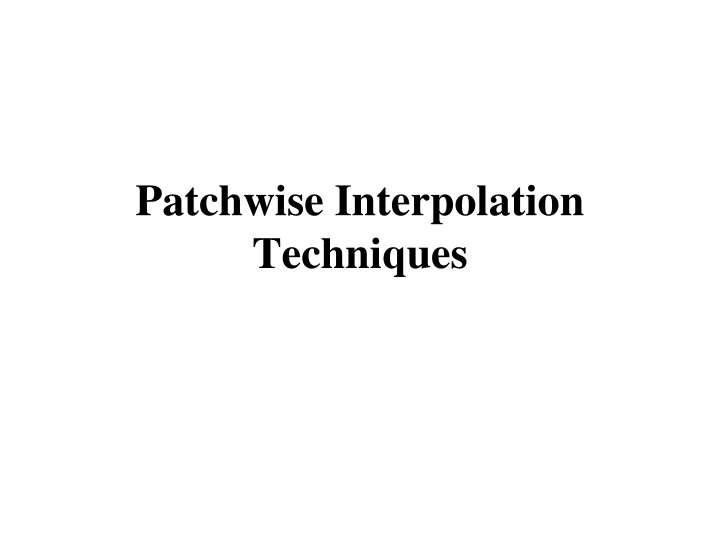
Patchwise and Local Interpolation Techniques Explained
Discover the difference between patchwise and local interpolation techniques, understand the general procedure, special considerations, and various methods used in local interpolation. Explore interpolation within TIN and the assumptions behind linear interpolation methods.
Download Presentation

Please find below an Image/Link to download the presentation.
The content on the website is provided AS IS for your information and personal use only. It may not be sold, licensed, or shared on other websites without obtaining consent from the author. If you encounter any issues during the download, it is possible that the publisher has removed the file from their server.
You are allowed to download the files provided on this website for personal or commercial use, subject to the condition that they are used lawfully. All files are the property of their respective owners.
The content on the website is provided AS IS for your information and personal use only. It may not be sold, licensed, or shared on other websites without obtaining consent from the author.
E N D
Presentation Transcript
Patchwise Interpolation Techniques
Local Versus Global Interpolation Techniques Global methods: Local variations have been considered as random, unstructured noise that had to be minimized. Local methods: Only use information from the nearest data points:
General Procedure Define a search area or neighborhood around the point to be interpolated; Find the data points within this neighborhood; Choose a mathematical model to represent the variation over this limited number of points; Evaluate the height at the interpolation point under consideration. Z = f(Zi) where Zi is the point in the search area
Local Interpolation: Special Considerations The size, shape, and orientation of the neighbourhood; The number of data points to be used; The distribution of the data points: Regular grid, irregularly distributed/TIN; The kind of interpolation function to use; The possible incorporation of external information on trends or different domains; All these methods smooth the data to some degree: They compute some kind of average value within a window.
Local Interpolation Techniques Interpolation from TIN data Linear Interpolation; 2nd Exact Fitted Surface Interpolation; Quintic Interpolation. Interpolation from grid/irregular data: Nearest neighbour assignment; Linear Interpolation; Bilinear interpolation; Cubic convolution; Inverse distance weighting (IDW); Optimal functions using geostatistics (Kriging).
Interpolation within a TIN TIN local interpolation methods honor the Z values at the triangle nodes Exact interpolation techniques Alternatives: Linear Second exact fit surface Bivariate Quintic
TIN Linear Interpolation: Assumptions Considers the surface as a continuous faceted surface formed by triangles The normal to the surface is constant Height calculated based solely on the Z values for the nodes of the triangle within which the point lies Produces continuous but not smooth surface
Linear Interpolation on TIN Continuous but not smooth surface
Linear Interpolation: Concept / Procedure Fit a plane through the triangle facet including the interpolation point. Use the fitted plane to estimate the elevation at the interpolation point.
2nd Degree Exact Fit Surface Assumes the triangles represent tilted flat plates Rationale: a better approximation can be achieved using curved or bent triangle plates, particularly if these can be made to join smoothly across the edges of the triangles. Exact and smooth technique Results in a very crude approximation
2nd Degree Exact Fit Surface: Procedure Find the three neighbour triangles closest to the faces of the triangle containing the point of interest Fit a second-degree polynomial trend to the points of the triangles The fitted surface is exactly passing through all six points
2nd Exact Fit Surface: Notes Contour curved rather than straight lines abrupt changes in direction crossing from one triangular plate to another
Grid Interpolation Techniques Use points sampled in a grid pattern Alternatives Nearest Neighbor Assignment. Linear interpolation. Inverse Distance Weighting. Cubic convolution. Bilinear interpolation. Krigging
Nearest Neighbour (NN) Interpolation Assigns the value of the nearest mesh point in the input lattice or grid to the output mesh point or grid cell. No actual interpolation is performed based on values of neighbouring mesh points.
NN Procedure Define the radius distance Search the area Quadrant search Octant search
NN Procedure Find the nearest point Assign the height of the point to the interpolated point Notes: No control over distribution and number of points used NN does not yield a continuous surface.
Inverse Weighted Distance (IWD) Points closer to interpolation point should have more influence The technique estimates the Z value at a point by weighting the influence of nearby data point according to their distance from the interpolation point. An exact method for topographic surfaces Fast Simple to understand and control
Inverse Weighted Distance: Computation
IDW: Example Interpolating a height point using W = 1/D Point distance 1 300 2 200 3 100 z value w 105 70 55 wi= ( di) = 0.0183 wizi= 105/300+70/200+55/100= 1.2499 Substituting in formula: 1.2499 0.0183 wz 0.3499 0.35 0.55 1/300 1/200 1/100 Z = 68.1764 using 1/D Z = 62.85 using 1/D2 Z = 57.96 using 1/D3
Contours Using Inverse Distance Squared (1/D2) 3360000 3358000 3356000 3354000 3352000 3350000 621000622000623000624000625000626000627000628000629000630000631000
Conclusions Interpolation of environmental point data is important skill Many methods classified by Local/global, approximate/exact, gradual/abrupt and deterministic/stochastic Choice of method is crucial to success Error and uncertainty Poor input data Poor choice/implementation of interpolation method Is it possible to use explanatory variables to improve interpolation, and if so, how?
